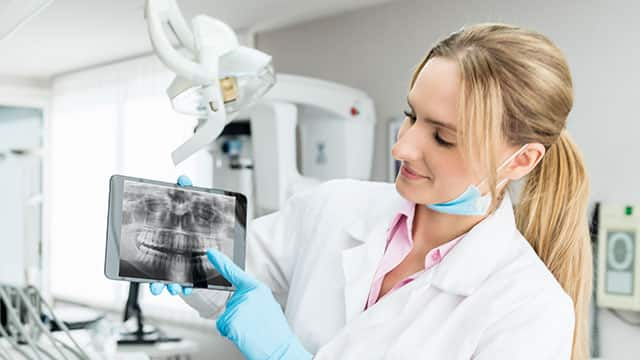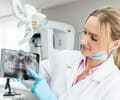What Is a Cephalometric X-Ray?
X-Rays are a technology used in medicine and dentistry that involves directing radiation (x-rays) at an area of the body to create an image of it. Bone and tissue block radiation, causing structures to appear on film or digitally as black, white, and grey. Specially trained professionals are then able to interpret the resulting image.
Cephalometric x-rays (also called ceph x-rays or radiographs) show a side view of your head, exposing teeth, jaw, and surrounding structures. This technology is considered safe and often useful or necessary to help professionals evaluate and assist patients. This specific type of x-ray is used in diagnosis and treatment planning.
Cephalometric x-rays may be used by dental professionals to assess:
- Impacted teeth
- Proper orthodontic treatment
- Problems with your temporomandibular joint (TMJ)
- Broken teeth or jaws
- Position of your jaw
- Some cancers
- Airway problems
Cephalometric X-Ray vs. Standard X-Ray
Cephalometric x-rays utilize much of the same technology as standard x-rays but have some important differences. This type of x-ray is taken from outside your mouth and does not typically require biting down on any equipment. This view is incredibly useful for many situations as it offers a large field of view, including your teeth, jaw, and profile.
While x-rays can make some uneasy, it’s a good idea to focus on the fact that they offer unique insight into your condition and your body's structure. The information cephalometric x-rays provide is often vital for medical and dental professionals to offer you the best possible care.
Cephalometric x-rays may be used for:
- Dental and orthodontic treatment planning: The use of cephalometric x-rays can expose disease or damage that are difficult or impossible to find during a normal dental examination. They offer a high level of precision to help guide your dental professional’s recommendations for your diagnosis and treatment. It's standard practice to establish your oral health baseline and track developments via imaging technology.
- Obstructive sleep apnea: Sleep specialists often recommend imaging to diagnose this sleep condition that can restrict your airway while sleeping. Cephalometric x-rays expose soft tissues in addition to bone and tooth structures, making them useful for conditions affecting your throat or airway.
- Temporomandibular disorder (TMD): This condition affects your jaw (temporomandibular) joint, cartilage, or bone and can cause discomfort. Professionals may recommend cephalometric x-rays to diagnose the condition, track changes, or help guide treatment.
- Other conditions or injury: As this type of x-ray offers a wide view of your head, neck, and mouth, they may be recommended for various conditions and injuries. According to the American Dental Association, the use of x-rays depends on a patient’s health, age, risk factors, and symptoms. If you don’t understand why you need a cephalometric x-ray, consult your medical or dental professional for clarification.
Cephalometric X-Ray Safety Concerns
It’s natural to experience some hesitation around technology that uses radiation, but you shouldn't worry. While the word itself can be unsettling, it’s important to keep in mind that we’re exposed to a safe level of radiation in our everyday lives. The amount of radiation we're exposed to during x-rays is small, according to the Cleveland Clinic.
X-rays are painless and safe, even for pregnant women in some cases. Professionals will take steps to limit the exposure to parts of your body by placing a leap apron on your chest or stomach.
If you experience radiation use anxiety, talk to the professional performing the imaging to ease your concerns. According to the American Dental Association, professionals follow the As Low As Reasonably Achievable (ALARA) principle to limit the amount of potential harm.
According to ALARA, professionals should only recommend x-rays if:
- The risk of exposure is justified relative to the benefits
- The number of exposures is as low as reasonably possible
- Exposure to patients is within allowable ranges
It may be stressful to need x-rays, but you can rest easy knowing that they’re a painless and safe technique with numerous benefits. This imaging technology provides professionals with an incredible amount of insight to guide their diagnosis and treatment recommendations. You should now have a great understanding of when cephalometric x-rays are used and why they’re essential for many.
Oral Care Center articles are reviewed by an oral health medical professional. This information is for educational purposes only. This content is not intended to be a substitute for professional medical advice, diagnosis or treatment. Always seek the advice of your dentist, physician or other qualified healthcare provider.
ORAL HEALTH QUIZ
What's behind your smile?
Take our Oral Health assessment to get the most from your oral care routine
ORAL HEALTH QUIZ
What's behind your smile?
Take our Oral Health assessment to get the most from your oral care routine
Join Us
Get the best of your oral health routine and take it to the next level with expert advice, recommendations, products and solutions and special offers.
Join Us
Get the best of your oral health routine and take it to the next level with expert advice, recommendations, products and solutions and special offers.















